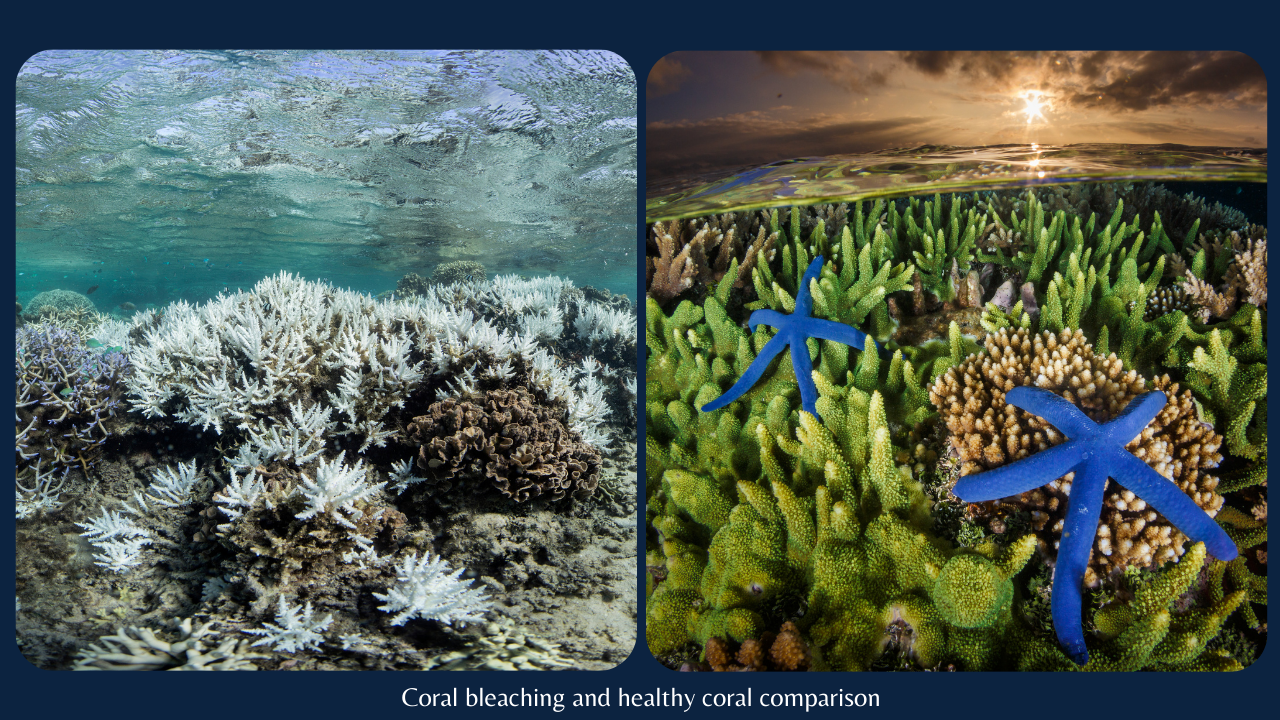With beautifully vibrant colors and fun, irregular shapes, coral reefs are one of the most memorable ecosystems in the world. Not only are they visually appealing, they are also functionally an invaluable part of our lives. Financially speaking, coral reefs help circulate about $375 billion into the world economy through tourism and the fish industry. Despite only taking up about 2% of our ocean’s surface area, they provide shelter to up to a quarter of all marine species. The biodiversity that arises from these ecosystems is breathtaking. Unfortunately, factors such as climate change are driving these animals to extinction. Although we are not completely sure why this occurs, corals are dying by the masses through something called coral bleaching. Corals have a symbiotic relationship with algae. The corals provide the algae with shelter while the algae provide “food” for the corals via photosynthesis. Those beautiful colors that you see when you go snorkeling are actually the algae photosynthesizing, not the corals. When environmental stressors are present such as extreme temperatures and acidic seawater, the algae are expelled from their coral hosts in the process known as coral bleaching. Once the algae are gone, the corals turn into nearly dead skeletons that are unlikely to survive for very much longer.
Causes of Coral Bleaching
As mentioned earlier, coral bleaching is a result of environmental stress, but there are still many unknowns that make us unsure about why it occurs. However, we have very good evidence to suggest that excessive heat is a major factor. Researchers have cultured corals in the lab and subjected them to extreme temperatures. They found that there was a direct correlation to increasing temperature and coral bleaching. Although this is only correlative evidence to support the extreme temperature theory, other researchers such as Henderson and Pockley also looked deeper into the molecular mechanism behind coral bleaching and found that algae with more genes that express heat shock proteins, or proteins that prevent cell damage from high temperatures, were less likely to be expelled from their coral hosts. These two pieces of evidence, along with the fact that mass bleaching events are correlated to seasonal heat waves, provide sufficient support to suggest that climate change is driving this extinction.

Solutions to the Crisis
To solve this problem, there are two major methods that have been employed to counter excessive heat. One is the establishment of marine protected areas (MPAs). MPAs are similar to national parks in that human destruction is lawfully prohibited. Furthermore, polluting the sea in these protected areas is illegal, as is overfishing (fish help eat aggressive macroalgae that would otherwise take over and out compete the corals). The issue with MPAs is that they are only local solutions that don’t solve the larger problem of climate change. Climate change is a global catastrophe that will destroy even protected local areas. In addition to MPAs, researchers have also started growing young corals in nurseries that do not experience as severe of heat waves as the major reef site. Once these corals have developed into adults, they are transplanted to the problem site that is losing corals too quickly. The issue with this method is that it’s only temporary. The corals that are grown in more lenient environments won’t survive in the harsher environment if excessive temperatures batter the area. A third possible solution that most people think about when considering coral bleaching is artificial selection. However, it was shown that corals with high thermal tolerance are not well-suited to pass down these genes. As you’ve probably noticed, the real solution to the coral bleaching catastrophe is to stop climate change now before we lose any more precious lives. According to the Sixth Assessment Report by the Intergovernmental Panel on Climate Change (IPCC) , the United Nations organization dedicated to assessing the science behind climate change, anthropogenic factors are “extremely likely” to be causing the high ocean temperatures that have been felt since the 70s. This means that it’s our human responsibility to make things right.

What Now?
So what can you do to stop climate change and save the coral reefs? At an individual level, there are many little things that you can do that can add up to have a great impact. For example, you can switch to renewable energy such as solar power for your home. Not only will this prevent greenhouse gas emissions, but this will also save you a lot of money in the long run with an average increase in home value by $15,000. Furthermore, you can also switch to a hybrid or electric car. Although you would still be emitting if your source of energy is something like coal, buying an electric vehicle (EV) will bring you one step closer to a sustainable lifestyle since your energy source may one day become solar or another clean renewable. However, there are environmental and social damages to electric vehicles such as those that stem from the source of cobalt for the batteries. The majority of cobalt for EVs is sourced from the Democratic Republic of Congo, where mining for this element results in chemical runoff into rivers and relocation orders for the residents. The better option is to reduce transportation in general rather than increasing demand for EVs to an unfeasible amount. A smaller, perhaps less intimidating choice is to use your voice and urge your government to make systemic changes. World leaders have already been coming together to have conversations and take action at gatherings such as the past COPs (Conferences of the Parties), and these have the potential to be powerful changemakers. To learn more ways to make a difference, there are abundant resources on the internet to help you along. Let’s fight this together!